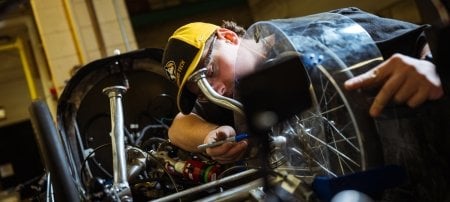Outreach Addresses Tribal Transportation on Reservations
John Velat, director of Michigan Tech’s Tribal Technical Assistance Program, has just returned from Washington, DC, Dallas, Seattle, and New York, where he traveled the high road to help Native American communities attain safe, efficient, and environmentally sound transportation.
A national leader in these state and federal efforts, Velat’s work ranges from the ordinary to the inspired—from training people to fix potholes and run graders to promoting tribal culture and self-determination.
The Tribal Technical Assistance Program (TTAP) is funded by the Federal Highway Administration. The seven TTAP programs in the country work with 566 federally recognized tribes. Tech has served the midwestern and eastern region since 1996, covering 32 states, ranging from all states that border the Mississippi to the Atlantic coast. Fourteen of these states have a total of 64 federally recognized tribes. “We have to reach every corner of the region,” Velat says. “It’s a big area but not many tribes, and not very big ones.”
Velat, a Michigan Tech alumnus, works out of the civil and environmental engineering department. In addition to him, the TTAP office includes Scott Bershing, technical editor, and Amanda Abramson, staff member.
Velat organizes training, provides technical assistance, and facilitates communication between tribes and governmental agencies to advance tribal transportation, including proper planning, construction, maintenance and safety.
In recent months, the TTAP at Tech has hosted sessions on road signage, operating heavy equipment, collecting and using traffic data, low-cost safety improvements and more. Much of Vela’s work is related to the $518 million Indian Reservation Road program, which is funded by the US Department of Transportation and the Bureau of Indian Affairs. The support is needed: tribal roads, Velat says, make up 2.6 percent of the roads in the US but receive less than 1 percent of the funding.
TTAP’s work frequently revolves around traffic safety. Velat says that, among American Indians and Alaskan Native populations, the motor vehicle fatality rates are two times greater than the general population, and pedestrian fatality rates are 3.5 times greater.
In a broader context, rural roads, where most tribes are located, are themselves troublesome, accounting for 39 percent of the vehicle miles traveled, but 61 percent of traffic fatalities. Factors prevalent in rural areas that can contribute to increased crash rates include lower income levels, lower education levels, lower seat belt and car seat use, higher rates of impaired driving, and narrow roads in need of repair.
To mitigate these factors and reduce death and injury rate in American Indian communities, TTAP focuses on what is called “the Four Es” of traffic safety: engineering, enforcement, education and emergency response.
Engineering involves the condition and design of roads. “Safe roads,” Velat says, “go hand in hand with well designed and maintained roads.” One example is rumble strips, which help reduce the worst crashes on rural roads by 95 percent.
Enforcement includes policing the speed limit and minimizing driving under the influence.
The educational component involves promoting safe driver behavior, including the use of seat belts and car seats.
Emergency response includes improving response times and capabilities during the “golden hour”—the first 60 minutes after a trauma event—to achieve a higher rate of survival, something more difficult in rural areas.
All these issues, Velat says, “are a big deal among tribes” as they endeavor to maintain their independence, their culture and their communities. “Transportation is one of the basic infrastructure needs of any community or culture. You need to be able to move people and goods around to sustain a community, and you need to do it safely.”
He sees his efforts, then, as helping tribes reinforce their sovereignty. He notes that there is a history of dialogue between the federal government and tribes as equal nations, but communication between tribes and state and local governments, such as county road commissions, is more wanting. “Tribes look to us to bridge that gap,” Velat says. “They look to us as an independent and objective source of information.”
He enjoys his work. “Some of the relationships you build with tribal communities are more personal,” he says. It’s not uncommon, he adds, to begin meetings and conferences with native prayers, drumming, and songs. “These traditions are empowering,” Velat says. “Though I don’t understand the words, it’s more than just a handshake—it’s a welcoming into the community.”
Professor emeritus Bernie Alkire started this initiative by writing a successful grant proposal to the Federal Highway Administration in 1996. He directed the program until 2011, when he retired. “It was rewarding work,” Alkire says. “I made a lot of trips. I met a lot of interesting people. I went to a lot of places I would never have gone.”
“The tribes are like every other group,” he says. “They have the same problems as everyone else—lots of need, not enough money.”
Through Michigan Tech TTAP, Velat concludes, American Indian communities have access to expertise and experience that meet some of that need at little to no cost.
Michigan Technological University is a public research university founded in 1885 in Houghton, Michigan, and is home to more than 7,000 students from 55 countries around the world. Consistently ranked among the best universities in the country for return on investment, Michigan’s flagship technological university offers more than 120 undergraduate and graduate degree programs in science and technology, engineering, computing, forestry, business and economics, health professions, humanities, mathematics, social sciences, and the arts. The rural campus is situated just miles from Lake Superior in Michigan's Upper Peninsula, offering year-round opportunities for outdoor adventure.




Comments